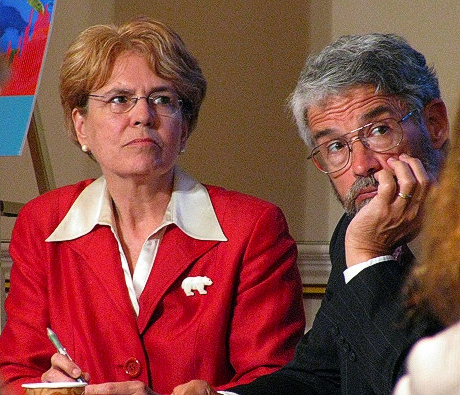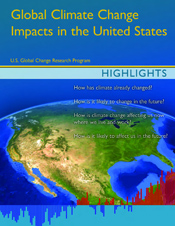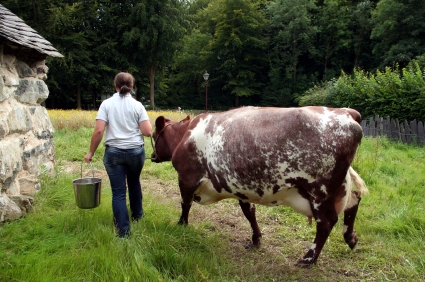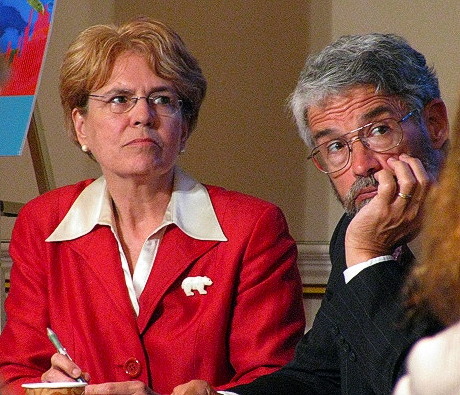Hey, remember the Florida Keys? You might have to, considering they won’t be there much longer if we continue pumping greenhouse gases into the atmosphere at current rates. Have plans to check out the Lone Star State? Well, you might want to get there soon, as Texas can expect up to 100 days of temperatures over 100 degrees by the end of century.
 NOAA chief Jane Lubchenco and Obama science adviser John Holdren unveiled the government’s new, massive report on climate change impacts.
NOAA chief Jane Lubchenco and Obama science adviser John Holdren unveiled the government’s new, massive report on climate change impacts.Failure to take action to curb emissions of greenhouse gases will result in significant changes to temperatures, rainfall patterns and sea level, and the effects are already underway.
That’s the blunt message the Obama administration is seeking to get across to the American public (and Congress!) with a multi-agency report released Tuesday breaking out current and future impacts of climate change by region of the country and economic sector. While work on the document began in March 2008, its release comes at a critical point in the debate over climate policy as the House of Representatives prepares to debate the American Clean Energy and Security Act (ACES) as early as next week.
“This report is a game-changer. I think that much of the foot-dragging in addressing climate change is a reflection of the perception that climate change is way down the road, it’s in the future and it only affects certain parts of the country,” said NOAA Administrator Jane Lubchenco at a press conference Tuesday. “This report demonstrates in concrete scientific information that climate change happening now, and it’s happening in our backyards.”
The report, issued by the U.S. Global Change Research Program, compiles work from 13 different government agencies, including the National Oceanic and Atmospheric Administration, the Environmental Protection Agency, and the departments of Agriculture, Interior, Defense, State, Energy. It details changes that scientists are already seeing, and issues a broad set of predictions for how the climate will change if greenhouse-gas emissions continue essentially unhindered, as well as a rosier scenario that assumes policies are put in place to curb emissions. The high-emissions scenario predicts dramatic changes in precipitation patterns, increase frequency of heat-waves and heat-related deaths, flooding, and sea-level rise. While the lower-emissions scenario does not completely rule out significant changes, it assumes most impacts would be far less severe.
The report breaks out impacts by region and looks at the sectoral impacts for agriculture and energy — two areas where industry has been resistant to action on climate change. Energy production would suffer due to decreased access to water supplies to cool power plants, the study predicts; farmers would face increased drought and pests.
Lubchenco emphasized in her remarks that there is now “greater confidence than ever before that human activities are the main cause of the changes that we see.”
Both Lubchenco and the report’s authors stressed that they believe the report shows that action to curb emissions can abate the worst consequences of climate change. “It’s not too late to act,” she said. “Decisions made now will determine whether we get big changes or small ones.”
John Holdren, director of the White House Office of Science and Technology and key science adviser to Obama, said the report is “intended to be accessible for officials at all levels of government.” Piggy-backing on his remarks, Lubchenco – who showed up to the presser sporting a polar bear broach — noted that it is also intended to be “relevant to the decisions that are being made today.”
Timing is everything
Administration officials said the report’s release was not scheduled with the intent of putting added pressure on Congress to pass the ACES bill. “This report is not about a particular policy or a particular piece of legislation,” said Holdren. “It is about the science telling us with ever greater clarity and persuasiveness why we need to act sooner rather than later.”
“That said,” he added, “it is a part of larger process of public and policymaker education about what the science is telling us. That has to be a part of what people think about particular legislation as we move ahead.”
The report came out on Tuesday simply “because it’s finished,” according to Jerry Melillo, a senior scientist at the Marine Biological Laboratory and a co-chair of the report.
But sources close to the process affirmed that Tuesday’s release is part of a coordinated effort to rally support for the ACES legislation. The administration is making sure that the document gets to key members of Congress. Report authors confirmed to Grist that they began holding briefings on the assessment on Capitol Hill on Monday and will continue the briefings throughout the week.
The administration also hired Resource Media, a San Francisco-based public relations firm, to help with messaging on the document.* Zach Warnow, a program coordinator at Resource Media, said the firm has been working on PR related to the report for about three-and-a-half months. The group has worked on a number of environment-relate projects in the past, including work on behalf of the Intergovernmental Panel on Climate Change. [*CORRECTION: Hunter Cuttings, the lead on this project at Resource Media, says the group was hired to work on website development and design for the project, not messaging, and that they worked with the government for about two months.]
At the same time, administration officials said they aren’t using the document as a policy prescription, but more as an impetus to action in general. “It’s science that will inform policy,” said Lubchenco. “It doesn’t dictate any particular solution, but it says this is important, we need to act sooner rather than later, this affects you.”
The officials on hand at Tuesday’s press conference would not weigh in on the whether the bill under debate in Congress is adequate in addressing the challenges outlined in the report.
“I’m not an expert on the Waxman-Markey bill,” said Melillo. “The idea that it’s trying to take action I think is a good thing.”
He said that many of the report’s authors are “regularly in contact with staffers” working for congressional lawmakers, however.
Environmental groups are split on whether the ACES bill is a good enough first step, or if it’s mere window dressing for an issue that demands immediate, dramatic changes to U.S. policy. Some groups are concerned that the bill’s 2020 targets in particular are not strong enough to slow near-term warming patterns. globalchange.gov
globalchange.gov
Others, including a colleague at Grist, are raising questions about just how high a priority climate action really is for the administration. As Obama’s science team was unveiling this major report, Obama fans received an email dispatch via BarackObama.com (the former campaign hub now operating as Organizing for America) rallying supporters on health care. Climate change and energy also did not come up a single time in the White House daily press briefing.
Grist caught up with Rick Piltz, who was a senior associate with the U.S. Global Change Research Program for ten years before leaving in March 2005 amid Bush-era censorship of climate reports. Piltz was on hand for Tuesday’s announcement, noting it was his first visit back to the White House grounds since he resigned. While the new administration is light years ahead on science and a stated desire to address climate change, he’s still concerned about how the White House is maneuvering on global warming legislation.
“It seems to me that so far the White House has adopted a messaging strategy on climate that very heavily emphasizes green jobs and clean energy, which is crucial, but that doesn’t have much of a vocabulary for impacts,” said Piltz, who now runs Climate Science Watch. “It seems to me that you’re really taking one of your weapons off the table if you never talk about why it’s so important to do something [about climate change]. What are the consequences of not doing something?”
“Obama will say everybody knows we need to do something about this,” he said. “Well, everybody doesn’t know,” he continued. “The public is not that alert and could use some presidential leadership.”
Greenpeace, which has been critical of the ACES legislation, came out with a strongly worded statement jabbing at the White House.
“The White House report on climate change is a stark confirmation of what scientists have been saying for years: unless we dramatically curb our emissions, the world will face unprecedented climate disruptions that will lead to drought, flooding, rising seas, food insecurity and mass displacement,” Greenpeace USA Climate Campaign Director Damon Moglen said in the statement. “But it begs the question: are the president and Congress taking the action necessary to avert this crisis?”
Turning up the heat
Even if President Obama himself doesn’t seize on the report to rally public support, environmentalists say Tuesday’s release will help them rally support for a bill in Congress.
“It should add motivation to solve this problem,” said David Doniger, policy director of the Climate Center at the Natural Resources Defense Council. “People care a lot more about the concrete changes that occur in their own state, cities, and backyards than they do about things that seem more abstract because they at a higher level or farther away.”
The report, said Tim Telleen-Lawton, a global warming advocate at Environment America, “really shows the power of acting now, acting quickly.”
Environment America has organizers working across the country, and the report gives their team members more ammunition when talking to citizens and legislators in specific regions.
“It’s a huge boost for us when we’re organizing in specific communities around the country,” said Telleen-Lawton. “The vast majority of the public realizes that something should be done about global warming, but I think people don’t realize how personal global warming is and how it will actually affect everyone.”
The lawmakers who have been most active on climate in Congress are already touting the report as evidence of the imminent need for action. “This report reinforces the science, renews our dedication to forging a national solution, and relegates the last bastions of climate denial to the dustbin of history,” said Rep. Ed Markey (D-Mass.), co-author of the ACES bill. “We waited for eight years to take any action on global warming, even as the evidence mounted. Our economy, our environment, and our planet can wait no longer.”
Sen. Barbara Boxer (D-Calif.), chair of the Environment and Public Works Committee, issued a similar statement: “The findings released today add urgency to the growing momentum in Congress for legislation that cuts global warming pollution, creates millions of clean energy jobs and whole new industries, and breaks our dependence on foreign oil.”
The scientists presenting the report also expressed hope that it will increase awareness of the current and potential impacts among those in Congress who have been unwilling to support political action on climate change.
“The observed changes are not changes to be debated,” said Thomas Karl, head of NOAA’s Climatic Data Center. “They are facts to be dealt with.”
[vodpod id=Video.16092247&w=425&h=350&fv=]–
Below, slides released by the U.S. Global Change Research Program:



